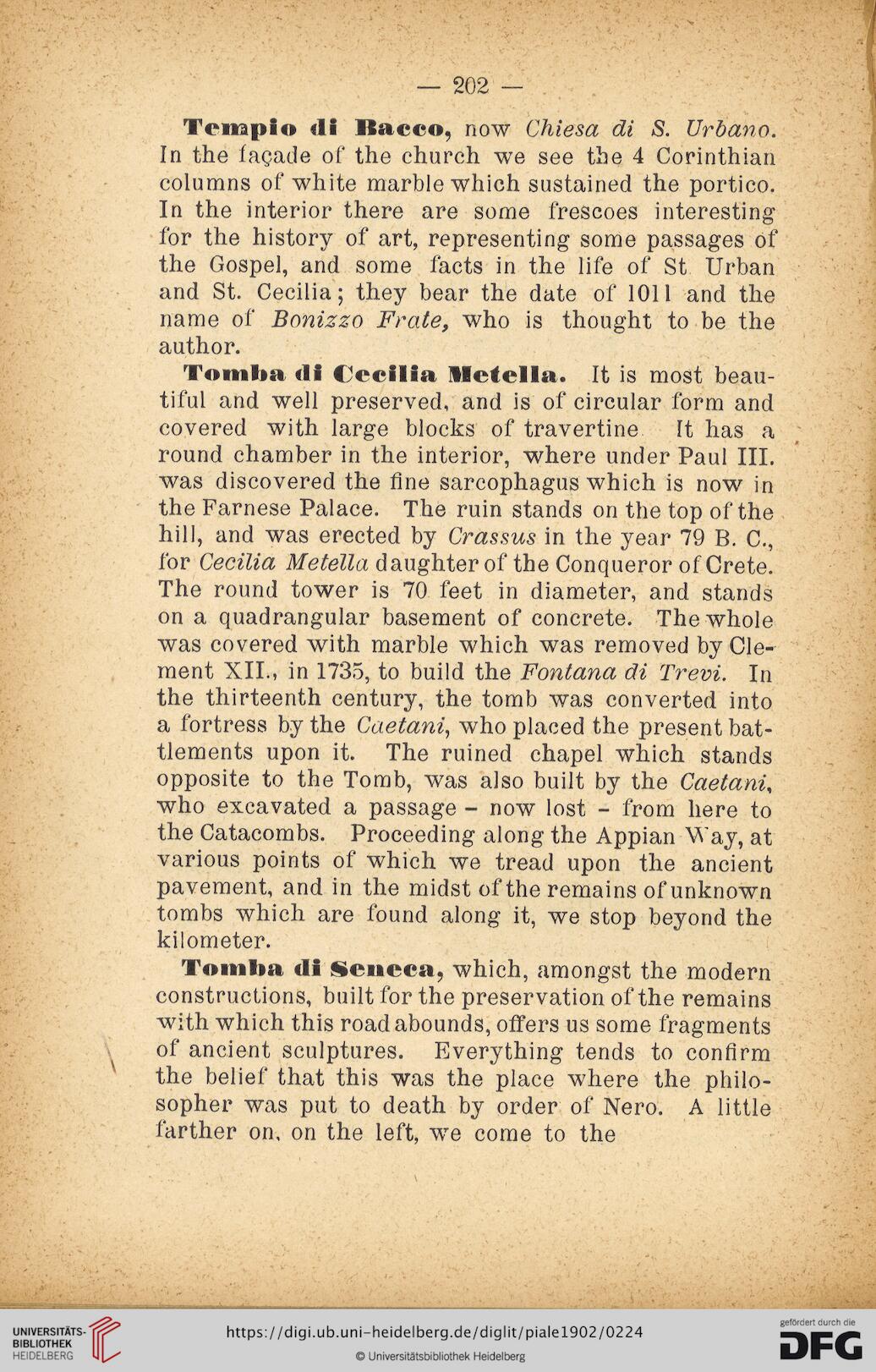— 202 —
Tempio di Bacco, now Chiesa di S. Urbano.
In the facade of the church we see the 4 Corinthian
columns of white marble which sustained the portico.
In the interior there are some frescoes interesting
for the history of art, representing some passages of
the Gospel, and some facts in the life of St Urban
and St. Cecilia; they bear the date of 1011 and the
name of Bonizzo Frate, who is thought to be the
author.
Tomba di Cecilia Metella. It is most beau-
tiful and well preserved, and is of circular form and
covered with large blocks of travertine It has a
round chamber in the interior, where under Paul III.
was discovered the fine sarcophagus which is now in
the Farnese Palace. The ruin stands on the top of the
hill, and was erected by Crassus in the year 79 B. C.,
for Cecilia Metella daughter of the Conqueror of Crete.
The round tower is 70 feet in diameter, and stands
on a quadrangular basement of concrete. The whole
was covered with marble which was removed by Cle-
ment XII., in 1735, to build the Fontana di Trevi. In
the thirteenth century, the tomb was converted into
a fortress by the Caetani, who placed the present bat-
tlements upon it. The ruined chapel which stands
opposite to the Tomb, was also built by the Caetani,
who excavated a passage - now lost - from here to
the Catacombs. Proceeding along the Appian Way, at
various points of which we tread upon the ancient
pavement, and in the midst of the remains of unknown
tombs which are found along it, we stop beyond the
kilometer.
Tomba di Seneca, which, amongst the modern
constructions, built for the preservation of the remains
with which this road abounds, offers us some fragments
of ancient sculptures. Everything tends to confirm
the belief that this was the place where the philo-
sopher was put to death by order of Nero. A little
farther on, on the left, we come to the
Tempio di Bacco, now Chiesa di S. Urbano.
In the facade of the church we see the 4 Corinthian
columns of white marble which sustained the portico.
In the interior there are some frescoes interesting
for the history of art, representing some passages of
the Gospel, and some facts in the life of St Urban
and St. Cecilia; they bear the date of 1011 and the
name of Bonizzo Frate, who is thought to be the
author.
Tomba di Cecilia Metella. It is most beau-
tiful and well preserved, and is of circular form and
covered with large blocks of travertine It has a
round chamber in the interior, where under Paul III.
was discovered the fine sarcophagus which is now in
the Farnese Palace. The ruin stands on the top of the
hill, and was erected by Crassus in the year 79 B. C.,
for Cecilia Metella daughter of the Conqueror of Crete.
The round tower is 70 feet in diameter, and stands
on a quadrangular basement of concrete. The whole
was covered with marble which was removed by Cle-
ment XII., in 1735, to build the Fontana di Trevi. In
the thirteenth century, the tomb was converted into
a fortress by the Caetani, who placed the present bat-
tlements upon it. The ruined chapel which stands
opposite to the Tomb, was also built by the Caetani,
who excavated a passage - now lost - from here to
the Catacombs. Proceeding along the Appian Way, at
various points of which we tread upon the ancient
pavement, and in the midst of the remains of unknown
tombs which are found along it, we stop beyond the
kilometer.
Tomba di Seneca, which, amongst the modern
constructions, built for the preservation of the remains
with which this road abounds, offers us some fragments
of ancient sculptures. Everything tends to confirm
the belief that this was the place where the philo-
sopher was put to death by order of Nero. A little
farther on, on the left, we come to the




